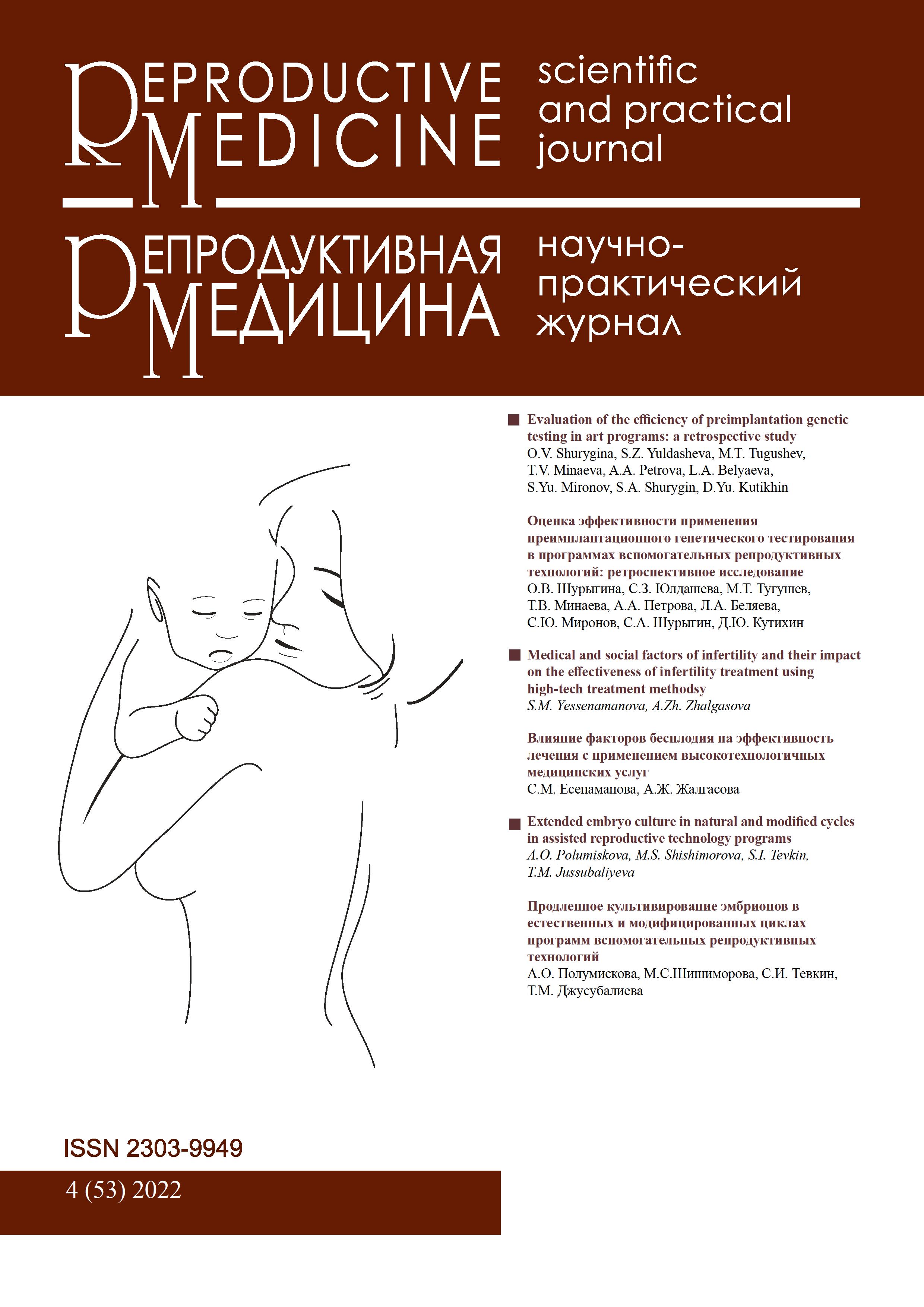The informative value of coagulation parameter screening examination to predict early miscarriage: A literature review
DOI:
https://doi.org/10.37800/RM.3.2022.55-62Keywords:
pregnancy, coagulopathy laboratory markers, thrombophilia, thrombosis, coagulation, reproductive lossesAbstract
Relevance: Assessment of gravida coagulation potential is one of the main components in predicting unfavorable reproductive outcomes. Such coagulation markers as prothrombin index (PTI), prothrombin time (PV), activated partial thromboplastin time (APTT), fibrinogen, and platelet index, are currently used in the first-trimester screening of pregnant women to detect
coagulopathies of various genesis. However, these markers have low prognostic efficacy. There is a need for more efficient laboratory markers to screen blood coagulation system disorders.
The study aimed to assess the prognostic value of coagulation markers (PTI, PV, APTT, fibrinogen, platelet counts) used in screening examinations of pregnant women in the first trimester to identify the risk of adverse pregnancy outcomes.
Methods: A literature search was carried out using PubMed, eLibrary, Cochrane, Scopus, and Web of Science databases. The search included clinical trials, meta-analyses, randomized controlled trials (RCTs), and systematic reviews published in the past decade. The search was done by keywords: “pregnancy,” “laboratory markers,” “coagulation,” and “miscarriage.”
Results: Currently, there is a question of revising and supplementing the existing screening markers of coagulation (PTI, APTT, Fibrinogen, platelet index) in favor of the latest markers presented: thrombomodulin (TM), thrombin-antithrombin complex (TAT), the complex of plasmin a2 inhibitors (PIC) and tissue plasminogen activator (tPAI-C). Considering their high importance in determining the coagulation potential of women of reproductive age as reliable markers of diagnosis of thrombosis with high sensitivity. This will significantly increase the efficiency of identifying individuals predisposed to coagulation disorders and reduce spontaneous reproductive losses.
Conclusion: New blood clotting markers TM, TAT, PIC, and tPAI-C offer high prognostic efficacy regarding violations of coagulation potential in pregnant women and high sensitivity regarding thrombosis. These markers require longer and deeper studies for diagnosing and predicting reproductive losses in women with negative pregnancy results in the first trimester.
References
Гончарова А.А. Кравченко Е.Н. Антифосфолипидный синдром в акушерской практике // Мать и дитя в Кузбассе. – 2018. – №1. – С. 52-56 [Goncharova A.A. Kravchenko E.N. Antifosfolipidnii sindrom v akusherskoi praktike // Mat i ditya v Kuzbasse – 2018. – №1. – S. 52-56 (in Russ.)]. https://www.elibrary.ru/item.asp?id=32424322.
Sekiya A., Hayashi T., Kadohira Y., Shibayama M., Tsuda T., Jin, X., Nomoto H., Asakura H., Wasa T., Ohtake S., Morishita E. Thrombosis Prediction Based on Reference Ranges of Coagulation-Related Markers in Different Stages of Pregnancy // Clin. Appl. Thromb./Hemost. – 2016. – Vol. 23(7). – P. 844-850. https://doi.org/10.1177/1076029616673732.
Медянникова И.В. Гемостазиологический контроль при беременности // Клиницист. – 2014. – №1. – C. 47-53 [Medyannikova I.V. Gemostaziologicheskii kontrol pri beremennosti // Klinicist. – 2014. – №1. – S. 47-53 (in Russ.)] https://klinitsist.abvpress.ru/Klin/issue/viewIssue/11/1.
Бегимбекова Л.М., Былантиева И.К. Опыт выявления факторов и степени риска развития тромбоза глубоких вен во время беременности // Вестник КазНМУ. – 2015. – №4. – С. 10-12 [Begimbekova L.M., Bylantieva I.K. Opyt vyyavleniya faktorov i stepeni riska razvitiya tromboza glubokikh ven vo vremya beremennosti // Vestnik KazNMU. – 2015. – №4. – S. 10-12 (in Russ.)]. https://kaznmu.edu.kz/press/2016/03/10/page/9/.
Marshall A.L. Diagnosis, treatment, and prevention of venous thromboembolism in pregnancy // Postgrad. Med. – 2015. – Vol. 126 (7). – P. 25-34. https://doi.org/10.3810/pgm.2014.11.2830.
Hansen A.T., Schmidt M., Horvath-Puho E., Pedersen L., Rothman K.J., Hvas A.M., Sørensen H.T. Preconception venous thromboembolism and placenta-mediated pregnancy complications // Thrombosis/Hemostasis. – 2015. – Vol. 13. – P. 1635-1641. https://doi:10.1111/jth.13046
Goodnight S.H., Hathaway W.E. Disorders of hemostasis and thrombosis. Clinical guide. – 2nd ed. – McGraw-Hill, Inc., 2001. – P. 622.
Акиньшина С.В., Бицадзе В.О. Тромбоэмболия легочной артерии в акушерской практике // Мед. Совет. – 2017. – №13. – С. 94-106. https://doi.org/10.21518/2079-701X-2017-13-94-108
Макацария А.Д., Бицадзе В.О., Хизроева Д.Х., Акиньшина С.В. Ведение беременности у пациенток с ишемическим инсультом в анамнезе // Ж. акушерства жен. болезней. – 2012. – №4. – C. 75-89 [Makacariya A.D., Bicadze V.O., Xizroeva D.X., Akin’shina S.V. Vedenie beremennosti u pacientok s ishemicheskim insul’tom v anamneze // Zh. akusherstva zhen. boleznej. – 2012. – №4. – S. 75-89 (in Russ.)]. https://www.elibrary.ru/item.asp?id=19066801.
Bozkurt M, Yumru AE, Sahin L, Salman S. Troponin I and DDimer levels in preeclampsia and eclampsia: prospective study // Clin. Experim. Obstetrics Gynecol. –2015. – Vol. 42(1). – P. 26-31. https://pubmed.ncbi.nlm.nih.gov/25864277/
Hao X., Jin Y., Cheng X., Yang L., Zhu L., Wang M. Phenotypic and genetic analysis of two pedigrees affected with hereditary antithrombin deficiency // Chin. J. Med. Genet. – 2016. – Vol. 33(2). – P. 145-149. https://doi.org/10.3760/cma.j.issn.1003-9406.2016.02.004.
Morikawa M., Kawabata K., Kato-Hirayama E., Oda Y., Ueda H., Kataoka S., Yamada T., Okuyama K., Sengoku K., Minakami H.J. Liver dysfunction in women with pregnancy-induced antithrombin deficiency // J. Obstet. Gynaecol. Res. – 2017. – Vol. 43(2). – P. 257-264. https://doi.org/10.1111/jog.13210
Diniz R.D., Souza R.M., Salvatori R., Franca A., Gomes-Santos E., Ferrão T.O., Oliveira C.R., Santana J.A., Pereira F.A., Barbosa R.A., Souza A.H., Pereira R.M., Oliveira-Santos A.A., Silva A.M., SantanaJúnior F.J., Valença E.H., Campos V.C., Aguiar-Oliveira M.H. Liver status in congenital, untreated, isolated GH deficiency // Endocr. Connect. – 2014. – Vol. 3(3). – P. 132-137. https://doi.org/10.1530/EC-14-0078.
Николаева М.Г., Сердюк Г.В., Момот К.А., Ясафова Н.Н., Момот А.П. Эффективность гепаринопрофилактики у носительниц мутации гена V фактора, генотип 1691GA во время беременности // Ж. акушерства жен. болезней. – 2017. – Т. 66, № S. – С. 52-53 [Nikolaeva M.G., Serdyuk G.V., Momot K.A., Yasafova N.N., Momot A.P. E’ffektivnost’ geparinoprofilaktiki u nositel’nic mutacii gena V faktora, genotip 1691GA vo vremya beremennosti // Zh. akusherstva zhen. boleznej. – 2017. – T. 66, №S. – S. 52-53 (in Russ.)]. https://elibrary.ru/item.asp?id=32243284
Shi H., Zheng H., Yin Y., Hu Q., Teng J., Sun Y., Liu H., Cheng X., Ye J., Su Y., Wu X., Zhou J., Norman G., Gong H., Shi X., Peng Y., Wang X., Yang, C. Antiphosphatidylserine/prothrombin antibodies (aPS/PT) as potential diagnostic markers and risk predictors of venous thrombosis and obstetric complications in antiphospholipid syndrome // CCLM. – 2018. – Vol. 56(4). – P. 614-624. https://doi.org/10.1515/cclm-2017-0502.
Chayoua W., Kelchtermans H., Moore G.W. Identification of high thrombotic risk triple-positive antiphospholipid syndrome patients is dependent on anti-cardiolipin and anti-β2glycoprotein I antibody detection assays // Thromb. Hemost. – 2018. – Vol. 16(10). – P. 2016-2023. https://doi.org/10.1111/jth.14261.
Liu T., Gu J., Wan L., Hu Q., Teng J., Liu H., Cheng X., Ye J., Su Y., Sun Y., Chi H., Zhou Z., Jia J., Wang Z., Zhou J., Norman G.L., Wang X., Yang C., Shi H. Anti-β2 GP Idomain 1 antibodiess tratifyhigh risk of thrombosis and late pregnancy morbidity in a large cohort of Chinese patients with antiphospholipid syndrome // Thromb. Res. – 2020. – Vol. 185. – P. 142-149. https://doi.org/10.1016/j.thromres.2019.11.029.
Schreiber P.W., Sax H., Wolfensberger A., Clack L., Kuster S.P. The preventable proportion of healthcare-associated infections 2005-2016: Systematic review and meta-analysis // Infect. Control Hosp. Epidemiol. – 2018. – Vol. 39(11). – P. 1277-1295. https://doi.org/10.1017/ice.2018.183.
Larsen E.C., Christiansen O.B., Kolte A.M., Macklon N. New insights into mechanisms behind miscarriage // BMC Med. – 2013. – Vol. 11(1). – Art. No. 154. https://doi.org/10.1186/1741-7015-11-154.
Murphy N., Broadhurst D., Khashan A., Gilligan O., Kenny L., O’Donoghue K. Gestation-specific D-dimer reference ranges: a cross-sectional study // BJOG. – 2015. – Vol. 122(3). – P. 395-400. https://doi.org/10.1111/1471-0528.12855.
Jiang L., Du Y., Lu Y., Wu X., Tong X. Monitoring of hemostatic parameters for early prediction of first-trimester miscarriage // Biomarkers. – 2021. – Vol. 26(6). – P. 532-538. https://doi.org/10.1080/1354750x.2021.1933592.
Wang W., Long K., Deng F., Ye W., Zhang P., Chen X., Yang K. Changes in levels of coagulation parameters in different trimesters among Chinese pregnant women // J. Clin. Lab. Anal. – 2021. – Vol. 35. – Art. ID: e23724. https://doi.org/10.1002/jcla.23724.
Cui C., Yang S., Zhang J., Wang G., Huang S., Li A., Qiao R. Trimester-specific coagulation and anticoagulation reference intervals for healthy pregnancy // Thromb. Res. – 2017. – Vol. 156. – P. 82-86. https://doi.org/10.1016/j.thromres.2017.05.021.
Gong J.-M., Shen Y., He Y.-X. Reference Intervals of Routine Coagulation Assays During the Pregnancy and Puerperium Period // J. Clin. Lab. Anal. – 2016. – Vol. 30(6). – P. 91-917. https://doi.org/10.1002/jcla.21956.
Власов В., Годзоева А., Кудряшова О., Козина О., Беляева О., Вавилова Т. Фибрин-мономер в практике лабораторной оценки гиперкоагуляционного состояния при беременности // Тромбоз, гемостаз и реология. – 2022. – №1. – С. 37-44 [Vlasov V., Godzoeva A., Kudryashova O., Kozina O., Belyaeva O., Vavilova T. Fibrin-monomer v praktike laboratornoĭ ocenki giperkoagulyacionnogo sostoyaniya pri beremennosti // Tromboz, gemostaz i reologiya. – 2022. – №1. – S. 37-44 (in Russ.)]. https://doi.org/10.25555/THR.2022.1.1007.
Struble E., Harrouk W., DeFelice A., Tesfamariam B. Nonclinical aspects of venous thrombosis in pregnancy // Birth Defects Res. Part C: Embryo Today: Rev. – 2015. – Vol. 105(3). – P. 190-200. https://doi.org/10.1002/bdrc.21111.
Riley P., Mardovina T., Bell P., Refaa, M. The Clinical Significance of Fibrin Monomers // Thromb. Haemost. – 2018. – Vol. 118(11). – P. 1856-1866. https://doi.org/10.1055/s-0038-1673684.
Akin M.N., Kasap B., Yuvaci H.U., Turhan N. Association between platelet indices and first trimester miscarriage // Blood Coagul. Fibrinol. – 2016. – Vol. 27 (5). – P. 526-530. https://doi.org/10.1097/MBC.0000000000000445.
Pasquier E., De Saint Martin L., Bohec C., Collet M., Dignat G.F., Mottier D Unexplained pregnancy loss: a marker of basal endothelial dysfunction? // Fertil. Steril. – 2013. – Vol. 100(4). – P. 1013-1017. https://doi.org/10.1016/j.fertnstert.2013.06.008.
Joly B., Barbay V., Borg J.-Y., Le Cam-Duchez V. Comparison of markers of coagulation activation and thrombin generation test in uncomplicated pregnancies // Thromb. Res. – 2013. – Vol. 132 (3). – P. 386-391. https://doi.org/10.1016/j.thromres.2013.07.022.
Maconi M., Cardaropoli S., Cenci A.M. Platelet Parameters in Healthy and Pathological Pregnancy // J. Clin. Lab. Anal. – 2012. – Vol. 26(1). – P. 41-44. https://doi.org/10.1002/jcla.20502.
Yang Y., Hu Y., Wu M., Xiang Z. Changes of new coagulation markers in healthy pregnant women and establishment of reference intervals in Changsha // J. Central South Univ. Med. Sci. – 2022. – Vol. 47(4). – P. 469-478. https://doi.org/10.11817/j.issn.1672-7347.2022.210536.
Downloads
Published
How to Cite
Issue
Section
License
The articles published in this Journal are licensed under the CC BY-NC-ND 4.0 (Creative Commons Attribution – Non-Commercial – No Derivatives 4.0 International) license, which provides for their non-commercial use only. Under this license, users have the right to copy and distribute the material in copyright but are not permitted to modify or use it for commercial purposes. Full details on the licensing are available at https://creativecommons.org/licenses/by-nc-nd/4.0/.




